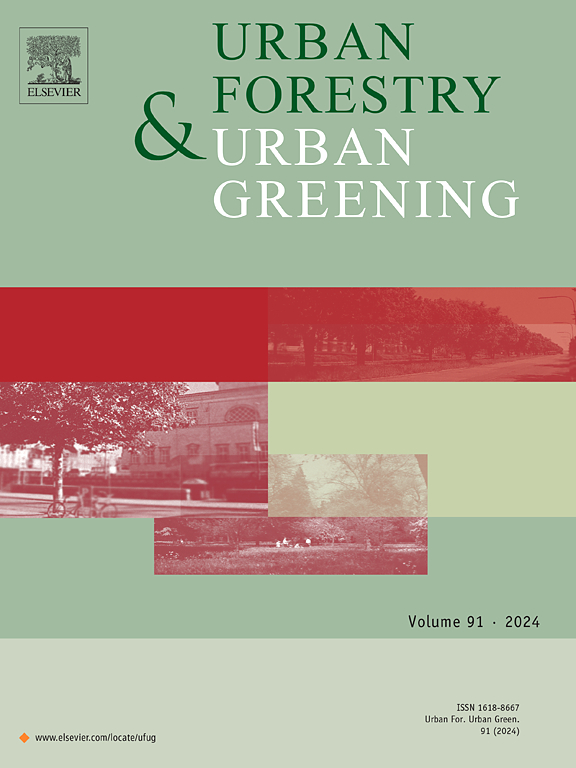Assessing urban rewilding potential: Plant diversity and public landscape perceptions in urban wildscapes of Harbin, China
IF 6
2区 环境科学与生态学
Q1 ENVIRONMENTAL STUDIES
引用次数: 0
Abstract
Urban rewilding has gained increasing attention as a strategy to restore ecological processes and enhance biodiversity in cities. Urban wilderness areas, by supporting spontaneous vegetation and minimal human intervention, offer both ecological benefits and opportunities for human-nature interactions. However, few studies have jointly examined plant diversity and public perception across different wilderness types within a single urban context. This study investigated 16 urban wilderness sites in Harbin, China, classified into three types—Remnant and Protected Wilderness (RPW), Vacant Lot Wilderness (VLW), and Industrial Derelict Wilderness (IDW). We conducted field surveys to assess species, functional, and phylogenetic plant diversity, and used a photo-questionnaire (n = 1570) to evaluate public perceptions of aesthetic appeal, restoration, and exploration. Results show that higher exposure to urban wilderness was associated with significantly greater perceived landscape value. RPW sites demonstrated stronger ecological-social synergy, while IDW sites showed weaker coupling coordination. Plant phylogenetic diversity and measured species richness were positively correlated with public perception metrics. The study underscores the potential of differentiated wilderness types to simultaneously advance biodiversity goals and social well-being, emphasizing the need for integrative, site-sensitive approaches to urban rewilding and green space planning.
城市再野化潜力评估:哈尔滨城市景观中的植物多样性和公众景观感知
城市野化作为一种恢复城市生态过程和增强城市生物多样性的策略,越来越受到人们的关注。城市荒野地区通过支持自然植被和最小的人为干预,为人类与自然的互动提供了生态效益和机会。然而,很少有研究联合调查了单一城市背景下不同荒野类型的植物多样性和公众感知。本研究以哈尔滨市16个城市荒野为研究对象,将其划分为遗迹与保护荒野(RPW)、空地荒野(VLW)和工业废弃荒野(IDW)三类。我们进行了实地调查,以评估植物的物种、功能和系统发育多样性,并使用照片调查问卷(n = 1570)来评估公众对美学吸引力、恢复和探索的看法。结果表明,城市荒野暴露程度越高,景观感知价值越高。RPW站点表现出较强的生态-社会协同作用,而IDW站点表现出较弱的耦合协调作用。植物系统发育多样性和测量物种丰富度与公众感知指标正相关。该研究强调了不同荒野类型在促进生物多样性目标和社会福祉的同时的潜力,强调了城市野生化和绿地规划需要综合的、对地点敏感的方法。
本文章由计算机程序翻译,如有差异,请以英文原文为准。
求助全文
约1分钟内获得全文
求助全文
来源期刊

Urban Forestry & Urban Greening
FORESTRY-
CiteScore
11.70
自引率
12.50%
发文量
289
审稿时长
70 days
期刊介绍:
Urban Forestry and Urban Greening is a refereed, international journal aimed at presenting high-quality research with urban and peri-urban woody and non-woody vegetation and its use, planning, design, establishment and management as its main topics. Urban Forestry and Urban Greening concentrates on all tree-dominated (as joint together in the urban forest) as well as other green resources in and around urban areas, such as woodlands, public and private urban parks and gardens, urban nature areas, street tree and square plantations, botanical gardens and cemeteries.
The journal welcomes basic and applied research papers, as well as review papers and short communications. Contributions should focus on one or more of the following aspects:
-Form and functions of urban forests and other vegetation, including aspects of urban ecology.
-Policy-making, planning and design related to urban forests and other vegetation.
-Selection and establishment of tree resources and other vegetation for urban environments.
-Management of urban forests and other vegetation.
Original contributions of a high academic standard are invited from a wide range of disciplines and fields, including forestry, biology, horticulture, arboriculture, landscape ecology, pathology, soil science, hydrology, landscape architecture, landscape planning, urban planning and design, economics, sociology, environmental psychology, public health, and education.
 求助内容:
求助内容: 应助结果提醒方式:
应助结果提醒方式:


